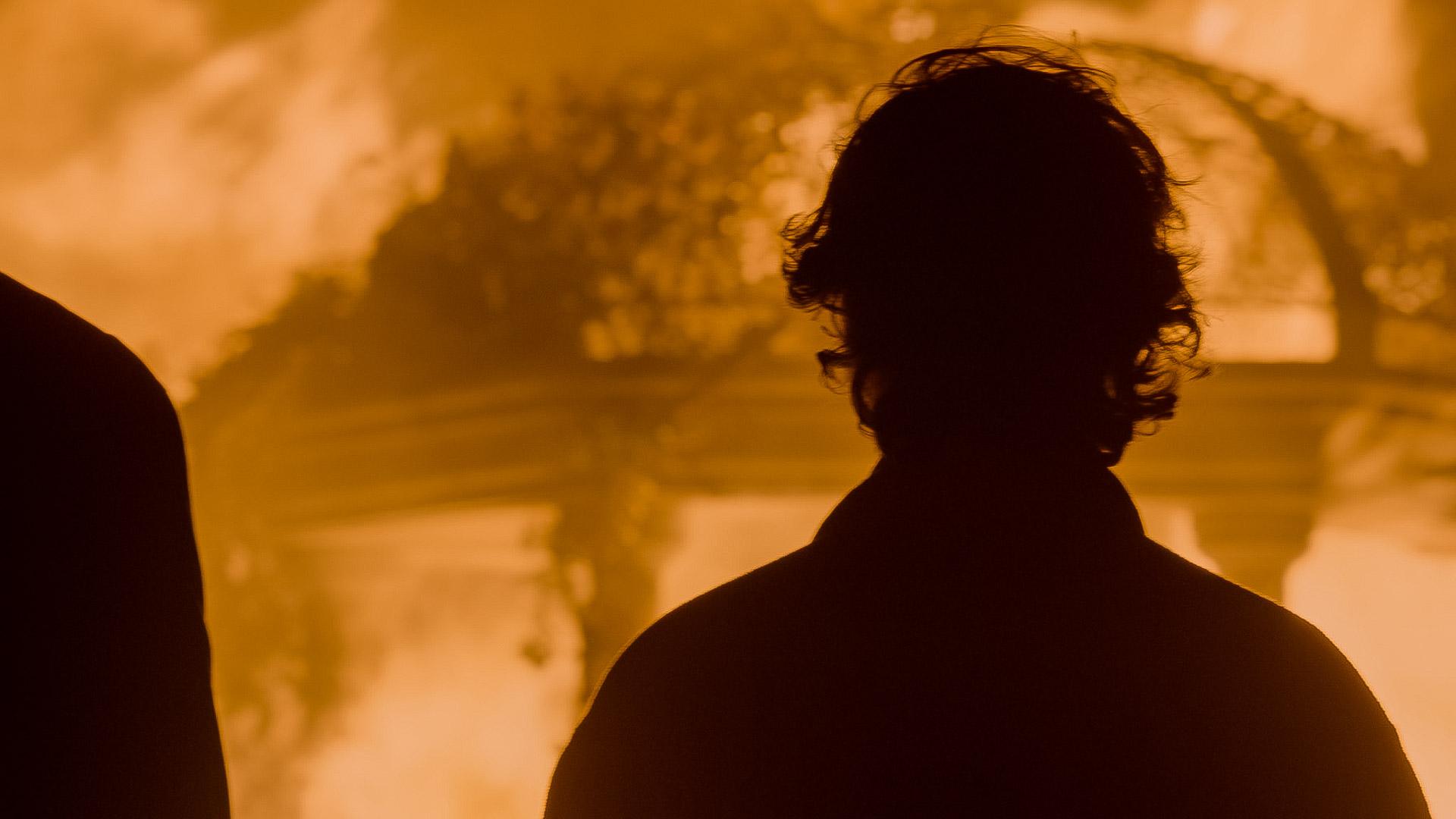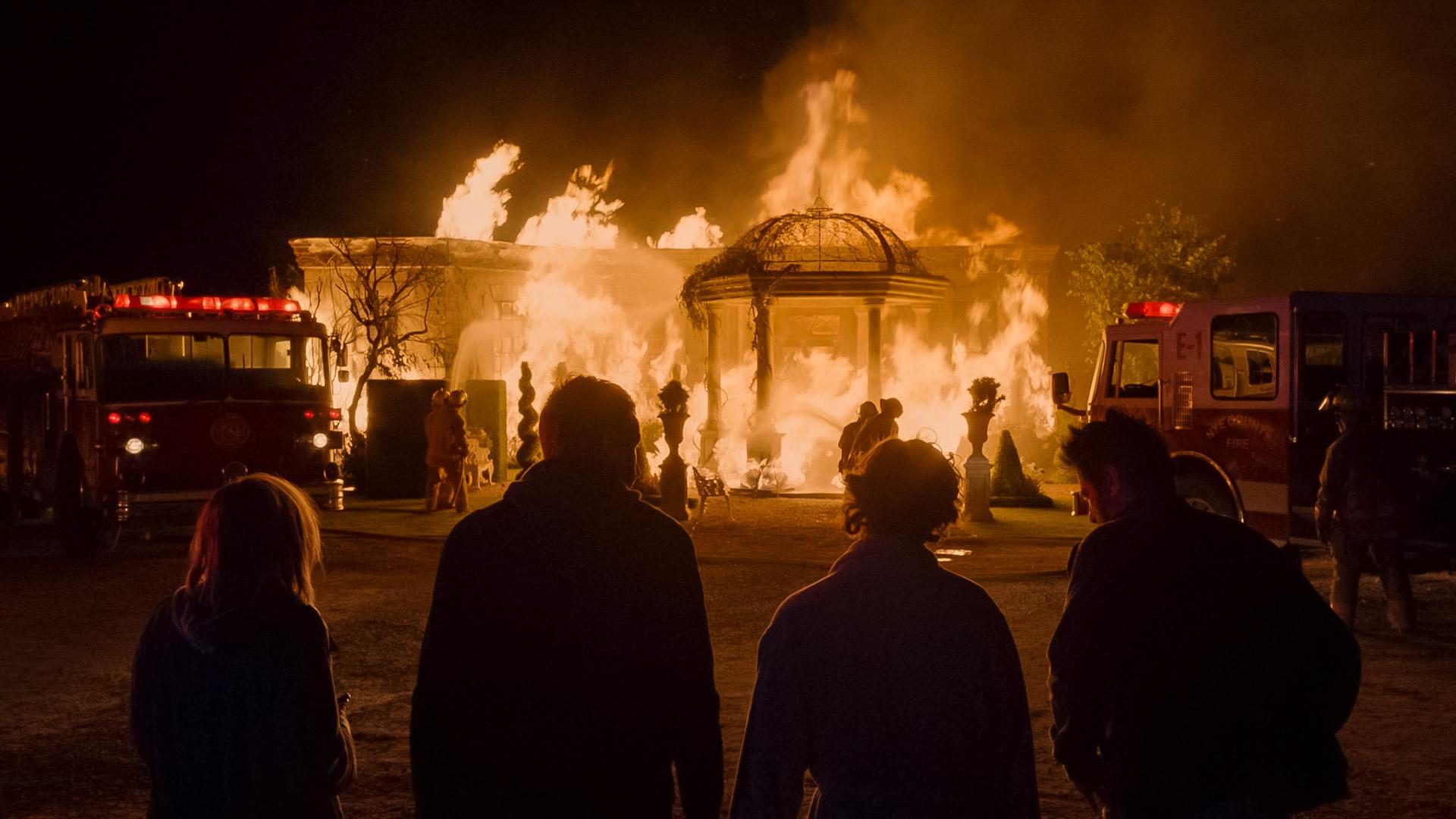Forum Replies Created
-
AuthorReplies
-
There might have been a rough sketch of the layout of vehicles in prep or a few days before but on the day, the director and I just worked with Transpo and Props to create a frame.
This was shot closer to f/11. But keep in mind, this was not an explosion but a continuous fire so I didn’t have to light the surrounding area to f/11, there was no before and after moment.

It’s from a TV series I did called “Get Shorty”, Season 1.
The truth is that it is hard to underexpose a fire — look at the burning of Atlanta scene in “Gone with the Wind” shot on 5-to-10 ASA 3-strip Technicolor.
So you try and light for a higher f-stop at night to hold color in a big fire, but everyone runs into practical limits. The big Cyberdyne night exterior on “Terminator 2” was lit to f/5.6 for 500 ASA film just to have a chance of holding detail in big explosion.
I had a large fire scene shot on the Alexa and could only light the night exterior to f/2.8 but once the fire got really big, I was at f/8-11 when pointing at the flames in the wide shot and when I zoomed in close, I was at f/11-16! Luckily it wasn’t an explosion; if it were, I would have tried to light the location to a deeper stop, like f/5.6.
Yes, using a camera with good overexposure latitude helps.

Raw is uncompressed plus color temperature and ISO are not baked in. And you can record Open Gate. Practically speaking, if you shoot carefully, the difference is subtle… the ProRes recording has a standard amount of sharpening built into it, so you may find that the footage feels slightly more “electronic” than a raw conversion with no sharpening.
You’re mainly trying to be consistent within the coverage of a scene. Individuals in a space may be in different lighting ratios but when you go from a wide shot to closer shots, you try and make it feel similar in contrast. If you’re cutting to a reverse angle not seen in the master wide shot, you are more free to create a different effect.
You can use a light meter of course if you are concerned. Often you light a master –let’s say to f/2.8 — and when you go into coverage, you might adjust the light on the actor but not touch the background light so if you light the actor to the same level as the master, then the background will look the same as before. The ratio you often set by eye, especially if you are going for that “barely visible” level of fill. But you can use a light meter or tools like false colors, waveforms, etc. if you’re not sure.
If shooting digital with a DIT on the crew, you can also save a frame of the master shot and compare the new set-up to see if they are in the same ballpark — do an A-B comparison.
Like in most situations where you have issues with balancing light sources, it often depends on what is the simplest solution. If the windows are large and provide the majority of light in the space, then the simplest thing is probably to add some green to all your other lights inside and then pull the overall green out of the image by either using a CC Magenta correction filter on the lens or shifting the color on the camera towards magenta.
If the windows are small and in the background, it might be easier to put some Minus Green gel on them. If it is a night scene, then you can add some Minus Green gel to the lighting outside the window to counteract the green that the glass will add.
—
Any grass that is off-camera and below the frame could be covered with something to reduce the green bounce coming off of the grass, like some sheets of muslin, bedsheets, etc. Any on-camera grass and bushes reflecting some green light into the room is at least a motivated effect.
For an editor to change the cinematographer’s work without a very good reason shows a lack of respect — a cinematographer wouldn’t come into the editing room and start changing cuts after all. Sometimes there is a good reason though — but an editor would usually tell the cinematographer what was going on and why they had to crop into the shot, etc.
I only once worked with an editor who routinely recomposed and even re-colored footage I shot, which was crazy. But the movie was not very good and the director was crazy, so I just let them do what they wanted to the footage. But it was really annoying — the editor only wanted to use close-ups so took all the medium and wide shots and zoomed into them to create even more close-ups and told me I wasn’t shooting enough close-ups!
The Varicon was a redesign of the original Lightflex, which flashed the image with white or colored light in front of the lens, sort of a controlled and even veil of light. The Panaflasher sat on the unused mag port on the Panaflex (there were two mag ports), and fogged the film inside the body of the camera as it ran through it.
Varicon and Panaflasher were ways of flashing the negative while filming. This lifted the blacks, which softened the colors and lowered the contrast. There was some minimal increase in shadow detail (it’s always hard to separate any increase in actual shadow information versus just the lifted blacks making the detail more apparent.)
Keep in mind that ENR was a print process – it involved adding b&w developer tanks to the FCP print processing line so that after the bleach step was skipped, a percentage of silver could be permanently developed and left in the print. For ECN processing (camera negative, intermediates) your only option was skip bleach or partial skip bleach.
The result when silver was left in a print was: (1) deeper blacks than the D-Max of the print stock, (2) less shadow detail due to increased contrast in the shadows, (3) darker colors that were somewhat desaturated from the addition of black silver in the dyes, (4) increase graininess in the print due to silver grains being added to the color dye clouds.
So this is really a color-correction for display / release format issue, not a sensor issue.
Sure, you can increase the contrast of the shadows and decrease the saturation using a LUT or basic DIT adjustments using ASC-CDL values for the display, the dailies, etc. As for the increase in graininess, you either have to live with just using a higher ISO for noise as a grain substitute — or use a film grain software in post, but then it probably would be added in the final color-correction, not in dailies or seen on set.
The last item, the increase in black levels beyond what is normally possible for a 35mm release print, that’s difficult to control, your only hope is to get the movie shown using laser projection (which is becoming more commonplace) and accepting that black level as a base.
Silver retention done to camera negative stocks had a somewhat different look than ENR. Leaving silver in a negative increases density and contrast in the highlights, not the shadows, since that’s where the silver is mostly formed. So highlights get hotter rather than shadows getting blacker. Color is desaturated from the addition of black silver. Graininess is heavier than when done to the print for the simple fact that grains in camera negative stocks are larger than on intermediate and print stocks, since those have a very low ASA.
You develop your own personal language based on your own emotional responses to light and color. I recall interviews with both John Boorman and Ingmar Bergman stating that they found the bright sunshine of California to be “oppressive” (of course they were also probably channeling their feelings towards Hollywood studios). Boorman said he found cold colors like blue to be “relaxing”. So there are limits to ascribing universal values to things like light and color.
Also keep in mind that even if your guide is the script, it’s not always necessary to mimic the emotions of a scene visually, what in literature is called “pathetic fallacy.” Sometimes the visuals can be a counterpoint to the emotions of a scene, like when a character gets bad news on a perfect spring day surrounded by nature.When I was coming up, often my 1st AC, my Key Grip, and my Gaffer were more experienced than I was so I could talk to them about specialized equipment like remote heads, telescoping cranes, etc. I also went to trade shows, read trade magazines, visited rental houses, read the specs on websites, owners manuals, etc.
May 2, 2023 at 5:51 am in reply to: Was No Country For Old Men initially intended to be 16:9? #21140535mm trailers were prepared in both 1.85 “flat” and 2.39 “scope” to match the feature presentation so that the projectionist would not have to change lenses and masks.
So clearly in this case the studio marketing division had access to an “open gate” D.I. master to make the 1.85 trailer (and any 16×9 unletterboxed versions needed.) of course, they should have made a 1.85 flat trailer with a 2.39 matte.
I use weather apps for the weather. I only use the Artemis as a lens preview or a lens finder that can record video or stills. I’m not aware of other features like drawing lighting diagrams, seems like that would be done on other apps.
-
AuthorReplies
